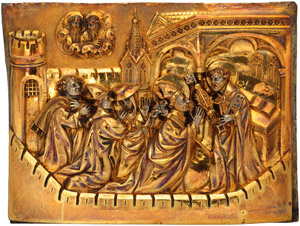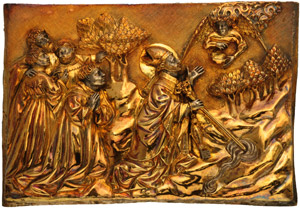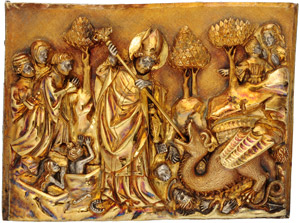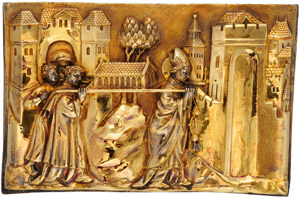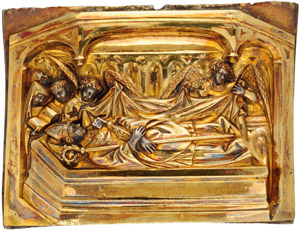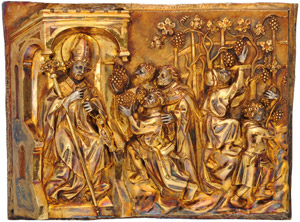Eight Plaques from the Saint Servatius Bust at St. Servatius in Maastricht
Museum für Kunst und Gewerbe Hamburg
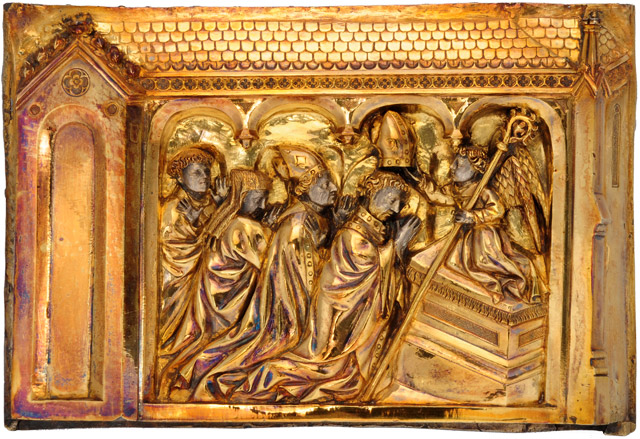
 Select the images above and right to zoom
Select the images above and right to zoom
In 1403, Duke Henry of Bavaria donated a reliquary bust of St. Servatius to the saint's eponymous church in Maastricht as a thanksgiving for a healing. The saint and Bishop of Tongeren had died in the city in 384 and had been the object of great reverence ever since. The eight silver gilt relief plaques, preserved at the Museum für Kunst und Gewerbe in Hamburg since 1885, probably adorned the—presumably polygonal—plinth of Duke Henry's reliquary bust. This bust was lost in the Duke of Parma's siege of Maastricht in 1579, but replaced in 1580 while the reliefs of the original reliquary were eventually exchanged for others, more in line with the taste of the time. In 1908, a new base was created for the 16th-century bust utilizing copies of the original reliefs made after the originals in the Hamburg.
The reliefs illustrate episodes from the life of St. Servatius with the narrative verve and realistic precision characteristic of contemporary Netherlandish painting. Two of the saint's relics, which have actually survived and are still kept to this day in the collegiate church in Maastricht (Diocese of Liège), recur on several of the plaques—the ivory crook of the Saint's pilgrim's staff and a large key, which, according to legend, Servatius had received from St. Peter himself.
The cycle begins with the appointment of Servatius to the bishopric of Tongeren. The first relief shows an angel presenting the mitre and crozier to Servatius as new Bishop of Tongeren (Fig. 1). This is followed by the handing over of the key by St. Peter (Fig. 2). Following the saint's vision of the impending downfall of Tongeren during a brief stay in Maastricht, Servatius sets out on a pilgrimage to Rome in order to beg St. Peter to intercede with God to avert the catastrophe. But Peter prophesizes that Servatius will find his last resting place in Maastricht, and hands over to him the key of the Gates of Heaven so that he may open up eternal life for all those who entreat for it. The key depicted on the plaque resembles in its form a silver key associated with St. Servatius, still kept in the treasury today. This may be an indication that the reliefs were made by a goldsmith who was familiar with Maastricht's sacred treasures. The pilgrim's staff carried by the bishop over his shoulder is a true-to-life copy of a 9th-century cane with a T-shaped ivory crook still preserved in the Maastricht treasury.
A chalice reputed to have been used by St. Servatius—and likewise kept in the treasury at Maastricht—is shown in the third relief. An angel descends from Heaven bringing it to the thirsty Saint, who has struck the rock with his staff to open it, producing a saving spring of water which is gushing out at his feet (Fig. 3). It was on the saint's way home from Rome that the miracle represented on the fourth plaque is said to have occurred. Not far from the Holy City the saint was waylaid and captured by a horde of heathen Huns. An eagle protected the sleeping man from the scorching heat of the sun, shading him with one wing and fanning him to create a breeze with the other. (Fig. 4). Attila, the King of the Huns, who is mounted on a horse, is so astounded at this wondrous sight that he turns the saint free and allows himself to be converted to Christianity by him. Another miracle which Servatius accomplished with the aid of his pilgrim's staff was the slaying of a dragon, depicted on the fifth plaque. The remains of human corpses lying around the monster and the children imploring him to save their lives suggest that the populace had been forced to bring the dragon children to be devoured as a tribute. Servatius put an end to their tribulations by thrusting the spike of his pilgrim's staff into the dragon's maw (Fig. 5). When Servatius arrives in Metz, respected burghers of Tongeren go out to meet him and beg him to accept the position of Bishop over his old diocese again. The saint does continue on to Tongeren, but only to reveal to the people of the city that the divine resolution to destroy the town is irrevocable. He has them gather the bones of the holy bishops and removes the Episcopal see to Maastricht.
The sixth relief shows the move from Tongeren to Maastricht. In the reliquary casket which Servatius and a second clergyman are carrying on their shoulders are the mortal remains of his canonized predecessors (Fig. 6). The procession is wending its way towards the city gates of Maastricht. One of the two spires of the church consecrated to Servatius can be seen in the background. The saint dies shortly afterwards in Maastricht, his death accompanied by miraculous celestial portents. Angels fly down and bear his soul aloft to heaven. Other angels are tending to the corpse. This is shown on the seventh plaque. Two angels cover the body with the heavenly robe, while three priests can be seen reciting prayers in the background (Fig. 7). St. Servatius is supposed to have appeared to heal people and perform miracles even after his death. On one occasion, two children climbed over the wall into the saint's vineyard at night in order to feast on the ripe grapes. A venerable old man then appears to them, chides them and casts a spell on them, which binds them fast to the vines, where they must wait for their relatives to find them. On the eighth plaque we can see the two children on the right, stuck fast to the vines while picking grapes (Fig. 8). The artists interpreted this episode to show the thieving hands severed from their arms and still clutching the grapes. On the left the children's relatives are approaching, praying and bringing grapes as votive offerings to the enthroned saint. His reliquary shrine, made around 1160, is preserved together with other, secondary relics of the saint, in the treasury of St. Servatius in Maastricht, one of the most important spiritual centres of the medieval period.
